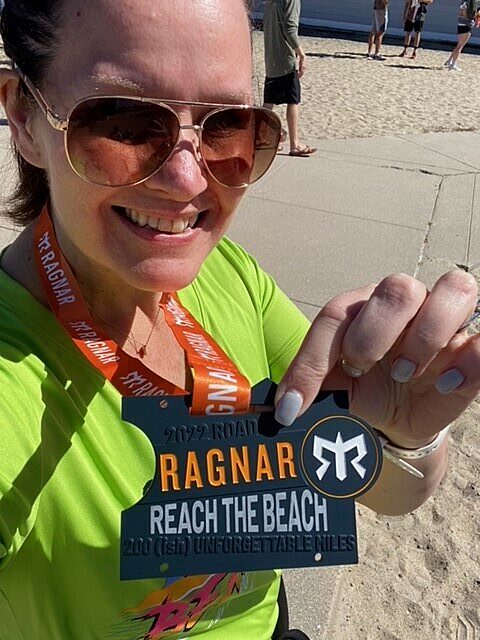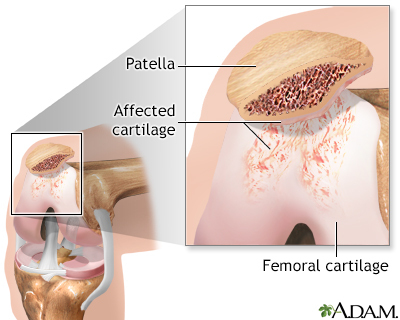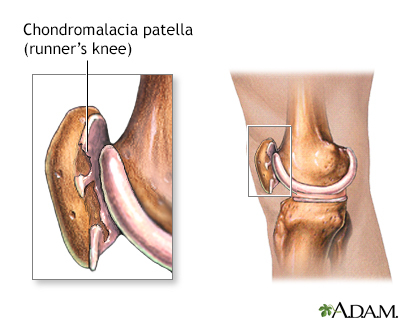The Race to Ragnar: Ann’s Journey to Pain-Free Running
Ann Scanlon started running as a means to lose weight. After making it a part of her daily routine, running became one of her hobbies, along with watching New…

Update your location to show providers, locations, and services closest to you.
Anterior knee pain is pain that occurs at the front and center of the knee. It can be caused by many different problems, including:
Patellofemoral syndrome; Chondromalacia patella; Runner's knee; Patellar tendinitis; Jumper's knee
Your kneecap (patella) sits over the front of your knee joint. As you bend or straighten your knee, the underside of the patella glides over the bones that make up the knee.
Strong tendons help attach the kneecap to the bones and muscles that surround the knee. These tendons are called:
Anterior knee pain begins when the kneecap does not move properly and rubs against the lower part of the thigh bone. This may occur because:
Anterior knee pain is more common in:
Other possible causes of anterior knee pain include:
Anterior knee pain is a dull, aching pain that is most often felt:
One common symptom is a grating or grinding feeling when the knee is flexed (when the ankle is brought closer to the back of the thigh).
Symptoms may be more noticeable with:
The health care provider will perform a physical exam. The knee may be tender and mildly swollen. Also, the kneecap may not be perfectly lined up with the thigh bone (femur).
When you flex your knee, you may feel a grinding feeling below the kneecap. Pressing the kneecap when the knee is straightening out may be painful.
Your provider may want you to do a single leg squat to look at muscle imbalance and your core stability.
X-rays are very often normal. However, a special x-ray view of the kneecap may show signs of arthritis or tilting.
MRI scans are rarely needed.
Resting the knee for a short period of time and taking nonsteroidal anti-inflammatory drugs (NSAIDs) such as ibuprofen, naproxen, or aspirin may help relieve pain.
Other things you can do to relieve anterior knee pain include:
Rarely, surgery for pain behind the kneecap is needed. During the surgery:
Anterior knee pain often improves with a change in activity, exercise therapy, and the use of NSAIDs. Surgery is rarely needed. However, if your knee has symptoms like instability or swelling, then you should see your doctor earlier.
Call your provider if you have symptoms of this disorder.


DeJour D, Saggin PRF, Kuhn VC. Disorders of the patellofemoral joint. In: Scott WN, ed. Insall & Scott Surgery of the Knee. 6th ed. Philadelphia, PA: Elsevier; 2018:chap 65.
Huntoon E, DEC Louise K, Caldwell M. Lower limb pain and dysfunction. In: Cifu DX, ed. Braddom's Physical Medicine Rehabilitation. 6th ed. Philadelphia, PA: Elsevier; 2021:chap 36.
McCarthyM, McCarty EC, Frank RM. Patellofemoral pain. In: Miller MD, Thompson SR, eds. DeLee, Drez, & Miller's Orthopaedic Sports Medicine. 5th ed. Philadelphia, PA: Elsevier; 2020:chap 106.
Teitge RA. Patellofemoral disorders: correction of rotational malalignment of the lower extremity. In: Noyes FR, Barber-Westin SD, eds. Noyes' Knee Disorders: Surgery, Rehabilitation, Clinical Outcomes. 2nd ed. Philadelphia, PA: Elsevier; 2017:chap 36.
Wilson H, Middleton R, Price A. The knee. In: Hochberg MC, Gravallese EM, Silman AJ, Smolen JS, Weinblatt ME, Weisman MH, eds. Rheumatology. 7th ed. Philadelphia, PA: Elsevier; 2019:chap 86.
Our community and patient programs provide great value to patients, families and loved ones. People can find support, educational materials, expert consultants and more. In most instances, these programs are offered free of charge.
Helps individuals with chronic musculoskeletal pain understand why they feel so much pain, and seeks ways to improve their lives.
Ann Scanlon started running as a means to lose weight. After making it a part of her daily routine, running became one of her hobbies, along with watching New…
